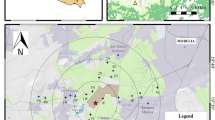Abstract
The lichen transplant monitoring methodology has been tested for source apportionment of metal deposition around the Cu smelter and former mining town of Karabash. Transplants of the lichen Hypogymnia physodes (L.) Nyl., collected from a ‘control’ site in July 2001, were set up at 10 stations along a 60 km NE–SW transect centred on Karabash. Samples were collected after 2 and 3 month monitoring periods and analysed using established wet-chemical techniques. The sources of particulate investigated were the smelter blast furnace and converter, floatation tailings, metallurgical slags, local road dusts, top soils and ambient airborne total suspended particulate. From multi-element least-squares modelling the blast furnace was the main source of particulate in transplants close to the smelter (<10 km). Particulate from the converter, with relatively high Pb and Zn, was found to be more widely dispersed, being finer-grained and so having a longer atmospheric residence time. Ambient airborne particulate, sampled in Karabash town using air-pump apparatus, was almost entirely derived from the converter, very different to the lichen transplants from the same area which mainly contained blast furnace particulate. It is proposed that lichens close to the smelter mainly trapped larger blast furnace-derived particulate as they have a low capture efficiency for smaller (converter) particles. The study demonstrates the utility of lichen transplants for monitoring atmospheric deposition and highlights the caution required in their use to assess ambient air quality in human health studies.
Similar content being viewed by others
References
Brown, D. H. (1987). The location of mineral elements in lichens: implications for metabolism. In E. Peveling (Ed.), Progress and problems in lichenology in the eighties (pp. 361–375). Berlin: Cramer.
Conti, M. E., & Cecchetti, G. (2001). Biological monitoring: lichens as bioindicators of air pollution assessment—a review. Environmental Pollution, 114, 471–492.
Gailey, F., Smith, G. H., Rintoul, L. J., & Lloyd, O. L. (1985). Metal-deposition patterns in central Scotland, as determined by lichen transplants. Environmental Monitoring and Assessment, 5, 291–309.
Garty, J. (2001). Biomonitoring atmospheric heavy metals with lichens: Theory and application. Critical Reviews of Plant Sciences, 20, 309–371.
Garty, J., Galun, M., & Kessel, M. (1979). Localization of the heavy metals and other elements accumulated in the lichen thallus. New Phytologist, 82, 159–168.
Jeran, Z., Jaćimović, R., Batič, F., Smodiš, B., & Wolterbeek, H. Th. (1996). Atmospheric heavy metal pollution in Slovenia derived from results for epiphytic lichens. Fresenius Journal of Analytical Chemistry, 354, 681–687.
Le Maitre, R. W. (1979). A new generalised petrological mixing model. Contributions to Mineralogy and Petrology, 71, 133–137.
MEI-Minerals Engineering International (2007). Russian Copper Company completes commissioning of Ausmelt copper smelter. Retrieved July 18, 2007, from http://www.min-eng.com/commodities/metallic/copper/news/122.html.
Mikhailova, I. (2002). Transplanted lichens for bioaccumulation studies. In P. L. Nimis, C. Scheidegger, & P. A. Wolseley (Eds.), Monitoring with lichens—monitoring lichens (pp. 301–304). Norwell: Kluwer.
Olmez, I., Gulovali, M. C., & Gordon, G. E. (1985). Trace-element concentrations in lichens near a coal-fired power-plant. Atmospheric Environment, 19, 1663–1669.
Pilegaard, K. (1979). Heavy metals in bulk precipitation and transplanted Hypogymnia physodes and Dicranoweisia cirrata in the vicinity of a Danish steelworks. Water, Air and Soil Pollution, 11, 77–91.
Polluted Places (2005). Karabash, Russia. New York: Blacksmith Institute. Retrieved June 1, 2005, from http://www.pollutedplaces.org/region/e_europe/russia/karabash.shtml
Purvis, O. W., Chimonides, P. J., Jones, G. C., Mikhailova, I. N., Spiro, B., & Weiss, D. J. (2004). Lichen biomonitoring near Karabash smelter town, Ural Mountains, Russia, one of the most polluted areas in the world. Proceedings of the Royal Society of London B, 271, 221–226.
Purvis, O. W., Longden, J., Shaw, G., Chimonides, P. D. J., Jeffries, T. E., & Jones, G. C. (2006). Biogeochemical signatures in the lichen Hypogymnia physodes in the mid Urals. Journal of Environmental Radioactivity, 90, 151–162.
Seaward, M. R. D. (1973). Lichen ecology of the Scunthorpe Heathlands. I. Mineral accumulation. Lichenologist, 5, 423–433.
Søchting, U. (1995). Lichens as monitors of nitrogen deposition. Cryptogamic Botany, 5, 264–269.
Spiro, B., Weiss, D. J., Purvis, O. W., Mikhailova, I., Williamson, B. J., & Coles, B. J. (2004). Lead isotopes in lichen transplants around a Cu smelter in Russia determined by MC-ICP-MS reveal transient records of multiple sources. Environmental Science and Technology, 38, 6522–6528.
Stepanov, A. M., Kabirov, R. R., Chernen’kova, T. V., Sadykov, O. F., Khanislamova, G. M., & Nekrasova, L. S., et al. (1992). Kompleksnaya ecologicheskaya ocenka tekhnogennogo vozdeistviya na ekosistemy yuzhnoi taigi (Integrated ecological assessment of technogenic impact on ecosystems of southern taiga). Moscow [In Russian]
Taylor, S. R., & McLennan, S. M. (1985). The continental crust: its composition and evolution. Oxford: Blackwell Scientific.
Udachin, V., Yershov, V., & Lansiart, M. (1998). Environmental conditions in the area of exploited massive sulfide deposits of the South Ural. Final Report for TACIS contract FINRUS 9602.
Valeeva, E. I., & Moskovchenko, D. V. (2002). Trace-element composition of lichens as an indicator of atmospheric pollution in northern West Siberia. Polar Geography, 26, 249–269.
Voskresensky, G. (2002). The most polluted city on the planet to breath easier. [Electronic version]. Eurasian Metals, 3 (Ecology). Retrieved from http://en.eurasmet.ru/online/2002/3/ecology.php.
Williamson, B. J., & Croft, S. (2001). Particulate analysis for environmental monitoring. Microscopy Today, 6, 42–43.
Williamson, B. J., Mikhailova, I., Purvis, O. W., & Udachin, V. (2004a). SEM–EDX analysis in the source apportionment of particulate matter on Hypogymnia physodes lichen transplants around the Cu smelter and former mining town of Karabash, South Urals, Russia. The Science of the Total Environment, 322, 139–154.
Williamson, B. J., Udachin, V., Purvis, O. W., Spiro, B., Cressey, G., & Jones, G. C. (2004b). Characterisation of airborne particulates in the Cu smelter and former mining town of Karabash, South Ural Mountains of Russia. Environmental Monitoring and Assessment, 98, 235–259.
Author information
Authors and Affiliations
Corresponding author
Rights and permissions
About this article
Cite this article
Williamson, B.J., Purvis, O.W., Mikhailova, I.N. et al. The lichen transplant methodology in the source apportionment of metal deposition around a copper smelter in the former mining town of Karabash, Russia. Environ Monit Assess 141, 227–236 (2008). https://doi.org/10.1007/s10661-007-9890-0
Received:
Accepted:
Published:
Issue Date:
DOI: https://doi.org/10.1007/s10661-007-9890-0




